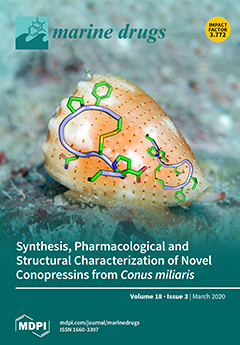The aims of this study were to investigate the antioxidant, hypolipidemic and hepatic protective effects of
Phascolosoma esculenta polysaccharides (PEP). PEP was prepared from
Phascolosoma esculenta by enzyme hydrolysis and its characterization was analyzed. The antioxidant activities of PEP were evaluated by the assays of scavenging 1,1-Diphenyl-2-picrylhydrazyl (DPPH), superoxide anion, hydroxyl radicals and chelating ferrous ion
in vitro. It showed that PEP could scavenge radicals effectively and had favorable antioxidant activities. In the meantime, the hypolipidemic effect of PEP was investigated
in vivo by using mice model fed with high-fat diet with or without PEP treatment. Compared with the hyperlipidemic mice without treatment, the serum levels of total cholesterol (TC) (30.1–35.7%,
p < 0.01), triglyceride (TG) (24.5–50.8%,
p < 0.01 or
p < 0.05), low-density lipoprotein cholesterol (LDL-C) (49.6–56.8%,
p < 0.01) and liver levels of TC (21.0–28.4%,
p < 0.01), TG (23.8–37.0%,
p < 0.01) decreased significantly, whereas serum high-density lipoprotein cholesterol (HDL-C) (47.7–59.9%,
p < 0.01 or
p < 0.05) increased significantly after treatment with different dosage of PEP (0.2, 0.4 and 0.8 g per kg body weight, respectively). In addition, superoxide dismutase (SOD) (10.2–22.2% and 18.8–26.9%,
p < 0.05), glutathione peroxidase (GSH-Px) (11.9–15.4% and 26.6–30.4%,
p < 0.05) activities in serum and liver enhanced markedly while aspartate aminotransferase (AST) (18.7–29.6% and 42.4–58.0%,
p < 0.05), alanine transaminase (ALT) (42.7–46.0% and 31.2–42.2%,
p < 0.05) activities, as well as the levels of malondialdehyde (MDA) (15.9–24.4% and 15.0–16.8%,
p < 0.01 or
p < 0.05) in serum and liver reduced markedly. Moreover, the histopathological observation of livers indicated that PEP could attenuate liver cell injury. The animal experimental results demonstrated that PEP exerted hypolipidemic and hepatoprotective roles in hyperlipidemic mice. In summary, our results above suggest that PEP might be a potential natural antioxidant and utilized as a therapeutic candidate for hyperlipidemia.
Full article






